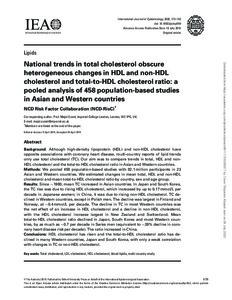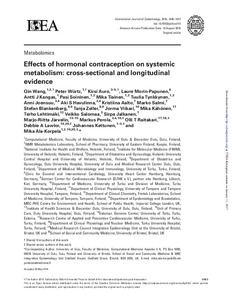Hae
Aineistot 51-60 / 389
Occurrence of fatal infective endocarditis: a population-based study in Finland
<div><h4>BACKGROUND: </h4><p>Infective
endocarditis (IE) is a serious mainly bacterial infection associated
with high mortality. Epidemiology of fatal IE is however largely
unknown. We studied occurrence and trends ...
Changes in BMI and physical activity from youth to adulthood distinguish normal-weight, metabolically obese adults from those who remain healthy
<p>Highlights</p><p>Adults with MONW have a lower BMI during youth until young adulthood, but higher BMI after this than adults with metabolically healthy normal weight. Adults with MONW have a greater decrease in physical ...
Sex Differences in Cardiovascular Outcomes of Older Adults After Myocardial Infarction
<p>Background Evidence on the impact of sex on prognoses after myocardial infarction (MI) among older adults is limited. We evaluated sex differences in long-term cardiovascular outcomes after MI in older adults. Methods and Results All patients with MI ≥70 years admitted to 20 Finnish hospitals during a 10-year period and discharged alive were studied retrospectively using a combination of national registries (n=31 578, 51% men, mean age 79). The primary outcome was combined major adverse cardiovascular event within 10-year follow-up. Sex differences in baseline features were equalized using inverse probability weighting adjustment. Women were older, with different comorbidity profiles and rarer ST-segment-elevation MI and revascularization, compared with men. Adenosine diphosphate inhibitors, anticoagulation, statins, and high-dose statins were more frequently used by men, and renin-angiotensin-aldosterone inhibitors and beta blockers by women. After balancing these differences by inverse probability weighting, the cumulative 10-year incidence of major adverse cardiovascular events was 67.7% in men, 62.0% in women (hazard ratio [HR], 1.17; CI, 1.13-1.21; P<0.0001). New MI (37.0% in men, 33.1% in women; HR, 1.16; P<0.0001), ischemic stroke (21.1% versus 19.5%; HR, 1.10; P=0.004), and cardiovascular death (56.0% versus 51.1%; HR, 1.18; P<0.0001) were more frequent in men during long-term follow-up after MI. Sex differences in major adverse cardiovascular events were similar in subgroups of revascularized and non-revascularized patients, and in patients 70 to 79 and ≥80 years. Conclusions Older men had higher long-term risk of major adverse cardiovascular events after MI, compared with older women with similar baseline features and evidence-based medications. Our results highlight the importance of accounting for confounding factors when studying sex differences in cardiovascular outcomes.</p>...
Global prevalence of WHO infant feeding practices in 57 LMICs in 2010-2018 and time trends since 2000 for 44 LMICs
<p>Background<br>The World Health Assembly set a global target of increasing exclusive breastfeeding for infants under 6 months to at least 50% by year 2025. However, little is known about the current status of breastfeeding ...
National trends in total cholesterol obscure heterogeneous changes in HDL and non-HDL cholesterol and total-to-HDL cholesterol ratio: a pooled analysis of 458 population-based studies in Asian and Western countries
<div><b>Background:</b> Although high-density lipoprotein (HDL) and non-HDL cholesterol have opposite associations with coronary heart disease, multi-country reports of lipid trends only use total cholesterol (TC). Our aim ...
Evaluation of the Association Between Health State Utilities and Obesity in Sub-Saharan Africa: Evidence From World Health Organization Study on Global AGEing and Adult Health Wave 2
<p>Background:Obesity is a major public health challenge and its prevalence has increased across the age spectrum from 1980 todate in most parts of the world including sub-Saharan Africa. Studies that derive health state ...
Effects of hormonal contraception on systemic metabolism: cross-sectional and longitudinal evidence
<h4>BACKGROUND:</h4><p>Hormonal contraception is commonly used worldwide, but its systemic effects across lipoprotein subclasses, fatty acids, circulating metabolites and cytokines remain poorly understood.</p><h4>METHOD ...
Weight gain in infancy and markers of cardiometabolic health in young adulthood
Aim We studied whether repeatedly measured weight gain from birth up to age 2 years associated with cardiometabolic health in young adulthood. Methods Using the data collected in the longitudinal Special Turku Coronary ...
Serum Proteomic Profiling to Identify Biomarkers of Premature Carotid Atherosclerosis
<p>To evaluate the presence of serum protein biomarkers associated with the early phases of formation of carotid atherosclerotic plaques, label-free quantitative proteomics analyses were made for serum samples collected ...
Attainment of Targets of the 20-Year Infancy-Onset Dietary Intervention and Blood Pressure Across Childhood and Young Adulthood The Special Turku Coronary Risk Factor Intervention Project (STRIP)
We examined whether success in achieving the key targets of an infancy-onset 20-year dietary intervention was associated with blood pressure (BP) from infancy to young adulthood. In the prospective randomized STRIP (Special ...









